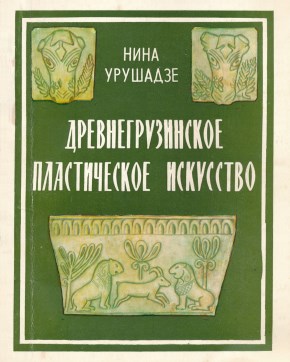 Н.Е. Урушадзе
Н.Е. Урушадзе
Древнегрузинское пластическое искусство.
// Тбилиси: «Хеловнеба». 1988. 182 с.
Содержание
Введение. — 3
Глава I. Древнейшие памятники фигуративной пластики Грузии. — 8
Глава II. Орнаментальные мотивы декора древнегрузинской керамики и металлопластика в их связи с раннеземледельческой изобразительной символикой. — 28
Глава III. Серебряный кубок Триалети как историко-этнографический источник. — 61
Глава IV. Место и значение декора колхидско-кобанских топоров в развитии традиционных форм древнегрузинской орнаментации. — 74
Глава V. Исходные формы древнегрузинской объёмной скульптуры. — 89
Глава VI. Образный строй ажурных поясных пряжек. — 121
Глава VII. Языческая символика в орнаментально-декоративных мотивах раннехристианских классических храмах Грузии. (Болнисский Сион, Джвари). — 147
Заключение. — 161
Рисунки. — 168
Таблицы. — 170
Литература. — 174
[Принятые сокращения. — 180]
Nina Urushadze
Plastic art in ancient Georgia. ^
Summary
This research reveals the ways of the formation and development of descriptive means and stylistic peculiarities in Old Georgian plastic art, it gives a historical, artistic and semantic analysis of the works of art of that period and defines their place and importance in the creation of national traditions.
A recreation of the formation and development of the artistic power of Georgian tribes at the time of their adopting the technique of metal plastic is of exceptional interest. This technique gave rise to new artistic forms and helped to develop and improve the methods of the previous times, the methods which had been created on the basis of the work with ceramic material and precious metals.
We find the starting point of the development in the sculptured figures of woman, belonging to the early agricultural period. Such figures are found in the reliefs of the Trialeti silver beaker, and though the patterns are to a certain extent unique, they have a lot of peculiarities that formed the basis of the semantic motivation of the later compositions in metal plastic art. The aim of the research is a comprehension of all the forms of metal plastic art existing at the bronze age, the decoration of Kolhk-Koban axes, the images. of open-work belt buckles, etc., and tracing the objective laws of their development. Those objective laws have already been defined on the material of belt reliefs (see Урушадзе H.E. Бронзовая летопись древней Грузии. 1 ч. Издательство «Хеловнеба», Тбилиси, 1984), and a lot of other monuments which also become traditional in artistic production.
The artistic and semantic analysis not only reveals that they represent the concepts imaginative power and artistic approach of the ancient masters, but it gives important additional data on the general objective laws of the formation and creation of the original peculiarities of the national style of Old Georgian decoration and particularly ornamentation. This principle can be spread, with full right, on a larger sphere of later artistic structures and images, which have become obligate for the whole Georgian national decoration. This is proved by examples of the same artistic approach in early-Christian monuments.
|